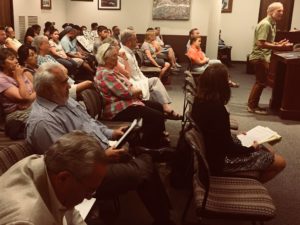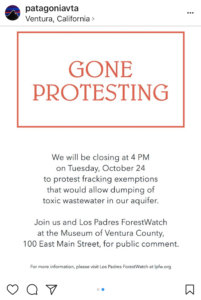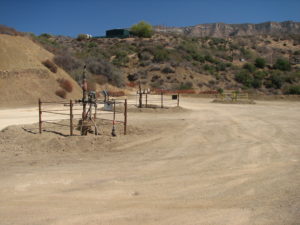In September of 2017, the California Division of Oil, Gas, and Geothermal Resources (DOGGR) announced that it was considering an application from an oil company seeking an exemption from the federal Safe Drinking Water Act to allow dumping of toxic wastewater into an underground aquifer beneath the Los Padres National Forest. Texas-based Seneca Resources submitted the exemption request after the U.S. Environmental Protection Agency (EPA) discovered in 2016 that they and other companies were discharging wastewater from oil operations into protected water supplies throughout California.
If DOGGR approves Seneca’s exemption application, it will be forwarded to the EPA for final consideration. If granted, the exemption would allow Seneca to continue using 13 active wastewater disposal wells in the Sespe Oil Field, and to possibly reactivate another 12 wastewater injection wells that are currently idle. Together, these 25 active and idle wastewater disposal wells have injected nearly 872 million gallons of produced water and fracking waste into the underlying aquifer, according to the exemption application submitted by Seneca. The exemption would pave the way for the expansion of oil operations in the Sespe Oil Field, including the controversial practice of fracking.
Overwhelming Opposition
DOGGR accepted public comments in October and November of last year. ForestWatch obtained the comments from DOGGR after submitting a Public Records Act request. Analysis of the 670 comments indicates that 98% were in opposition to the proposed exemption. Many of the comments were submitted by residents of Fillmore, a small town whose only source of drinking water comes from the Fillmore Groundwater Basin less than a mile away from the Sespe Aquifer in which fracking waste would be dumped.

Local residents attend a Fillmore City Council meeting to voice their opposition to the proposed aquifer exemption.
The City of Fillmore submitted a letter opposing the proposed exemption. Assemblymember Monique Limón also submitted a letter to DOGGR. Several geologists, engineers, ecologists, and even former DOGGR employees submitted opposition comments as well. Farmers from the Fillmore area opposed the proposal, citing concerns over contamination of their only source of irrigation, many of whom also mentioned that the safety of private water wells close to the proposed exemption area are not being taken into consideration. In addition to the detailed letter of opposition submitted by ForestWatch, other groups such as Citizens for Responsible Oil and Gas, California Trout, Center for Biological Diversity, Keep the Sespe Wild, and California Wilderness Coalition also sent in comments opposing the proposal. ForestWatch also retained a licensed professional geologist to review the highly technical proposal, who concluded that the aquifer proposed for dumping may be hydrologically connected to Sespe Creek and drinking water supplies. We submitted his findings to DOGGR during the comment period.
Only 18 comments supported the proposed exemption and nearly all of them came from people with ties to the oil industry, including retired petroleum engineers, an oil lobbying group, consulting firms with oil industry clients, and a fracking company.
 DOGGR also held a public hearing in Ventura with more than 150 people in attendance, including several families. After a long and highly technical presentation, DOGGR leadership gave 42 members of the public an opportunity to voice their opinions on the proposal, but limited their speaking time to only two minutes each. During his brief testimony, ForestWatch executive director Jeff Kuyper explained the importance of the Sespe watershed to wildlife, recreation, and downstream water users, and urged the state officials to allow more time for the public to voice their concerns. Most people who provided testimony at the hearing were opposed to allowing an oil company to dump toxic wastewater in the Sespe aquifer. Again, nearly all of those who spoke in favor of the exemption admitted to having direct ties to the oil industry.
DOGGR also held a public hearing in Ventura with more than 150 people in attendance, including several families. After a long and highly technical presentation, DOGGR leadership gave 42 members of the public an opportunity to voice their opinions on the proposal, but limited their speaking time to only two minutes each. During his brief testimony, ForestWatch executive director Jeff Kuyper explained the importance of the Sespe watershed to wildlife, recreation, and downstream water users, and urged the state officials to allow more time for the public to voice their concerns. Most people who provided testimony at the hearing were opposed to allowing an oil company to dump toxic wastewater in the Sespe aquifer. Again, nearly all of those who spoke in favor of the exemption admitted to having direct ties to the oil industry.
Before the hearing, our friends at Patagonia hosted a sign-making party at the Great Pacific Iron Works store in Ventura, just around the corner from the hearing location. The store closed early so that its employees could attend the hearing.
Next Steps
The proposal must be approved by DOGGR before they submit it to the EPA where it will be considered for final approval. No timeline for this decision has yet been established, but the process typically takes 2-4 months. ForestWatch will continue to fight aquifer contamination and expansion of oil operations in the Sespe Oil Field. Check our website for updates on the status of the proposal and how you can help protect water resources in and around the Los Padres National Forest.








Comments are closed.